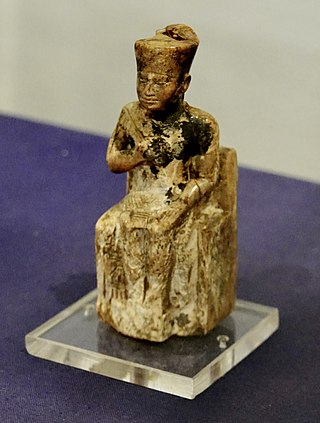
Khufu or Cheops was an ancient Egyptian monarch who was the second pharaoh of the Fourth Dynasty, in the first half of the Old Kingdom period. Khufu succeeded his father Sneferu as king. He is generally accepted as having commissioned the Great Pyramid of Giza, one of the Seven Wonders of the Ancient World, but many other aspects of his reign are poorly documented.

Khafre or Khafra, also known as Khephren or Chephren, was an ancient Egyptian pharaoh of the Fourth Dynasty during the Old Kingdom. He was the son of Khufu and the successor of Djedefre.

Hetepheres II was a Queen of Ancient Egypt during the 4th Dynasty.
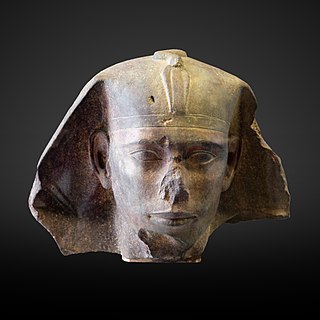
Djedefre was an ancient Egyptian king (pharaoh) of the 4th Dynasty during the Old Kingdom. He is well known by the Hellenized form of his name Rhatoisēs (Ῥατοίσης) by Manetho. Djedefre was the son and immediate throne successor of Khufu, the builder of the Great Pyramid of Giza; his mother is not known for certain. He is the king who introduced the royal title Sa-Rê and the first to connect his cartouche name with the sun god Ra.

The Fourth Dynasty of ancient Egypt is characterized as a "golden age" of the Old Kingdom of Egypt. Dynasty IV lasted from c. 2613 to 2494 BC. It was a time of peace and prosperity as well as one during which trade with other countries is documented.
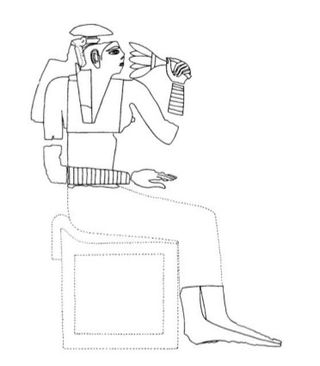
Hetepheres I was a queen of Egypt during the Fourth Dynasty of Egypt who was a wife of one king, the mother of the next king, the grandmother of two more kings, and the figure who tied together two dynasties.
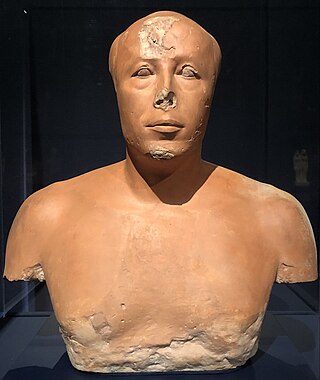
Ankhhaf was an Egyptian prince and served as an overseer during the reign of the Pharaoh Khufu, who is thought to have been Ankhhaf's half-brother. One of Ankhaf's titles is also as a vizier, but it is unknown which pharaoh he would have held this title under. He lived during Egypt's 4th Dynasty.
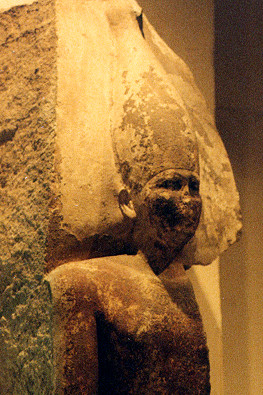
Sneferu, well known under his Hellenized name Soris, was the founding pharaoh of the Fourth Dynasty of Egypt during the Old Kingdom. Estimates of his reign vary, with for instance The Oxford History of Ancient Egypt suggesting a reign from around 2613 to 2589 BC, a reign of 24 years, while Rolf Krauss suggests a 30-year reign, and Rainer Stadelmann a 48-year reign. He built at least three pyramids that survive to this day and introduced major innovations in the design and construction of pyramids.
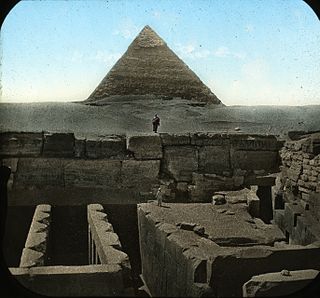
Minkhaf I was an ancient Egyptian prince of the 4th Dynasty. He was a son of Pharaoh Khufu, half-brother of Pharaoh Djedefre and elder brother of Pharaoh Khafre. His mother may have been Queen Henutsen. Minkhaf had a wife and at least one son, but their names are not known. Minkhaf served as vizier possibly under Khufu or Khafre.
Meritites I was an ancient Egyptian queen of the 4th Dynasty. Her name means "Beloved of her Father". Several of her titles are known from a stela found at Giza. She was buried in the middle Queen’s Pyramid in Giza.
Djedefhor or Hordjedef was a noble Egyptian of the 4th Dynasty. He was the son of Pharaoh Khufu and his name means "Enduring Like Horus".
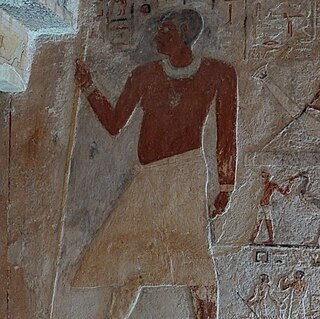
Kawab is the name of an ancient Egyptian prince of the 4th Dynasty. He was the eldest son of King Khufu and Queen Meritites I. Kawab served as vizier and was buried in the double mastaba G 7110–7120 in the east field which is part of the Giza Necropolis.
Khufukhaf I was an ancient Egyptian prince and vizier of the 4th Dynasty.
Meritites, also spelled Meryetites, Meritates, etc. (mr.t-ỉt=s; “beloved of her father”) was an ancient Egyptian female name. Its notable bearers were:

Neferhetepes was an ancient Egyptian princess of the 4th Dynasty; a daughter of Pharaoh Djedefre who ruled between his father Khufu and his brother Khafre. Her mother was Hetepheres II.
Khentetka or Khentetenka was a Queen of Egypt; the wife of King Djedefre during the 4th Dynasty.

Mindjedef was a Prince of ancient Egypt, who lived during the 4th Dynasty. His name means "Enduring Like Min". Min is an Egyptian fertility god.

Meresankh II was a Queen of Egypt who lived during 4th Dynasty.
Princess Hetepheres was an Egyptian princess who lived during the 4th Dynasty. Hetepheres was the daughter of King Sneferu and the wife of vizier Ankhhaf.
Meresankh is the name of several royal women from the Old Kingdom in Ancient Egypt. It means "she loves life" and was popular during the 4th dynasty.